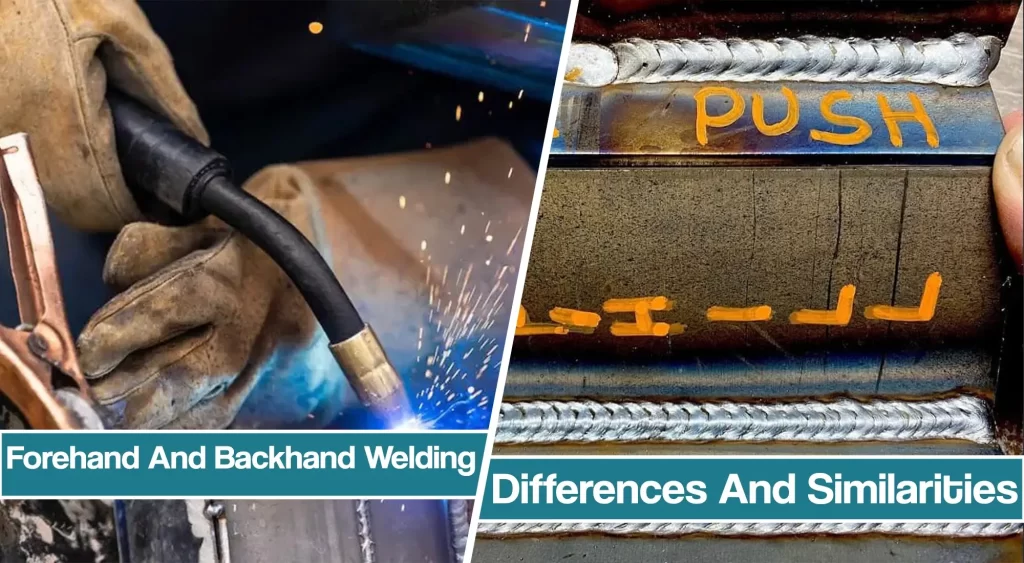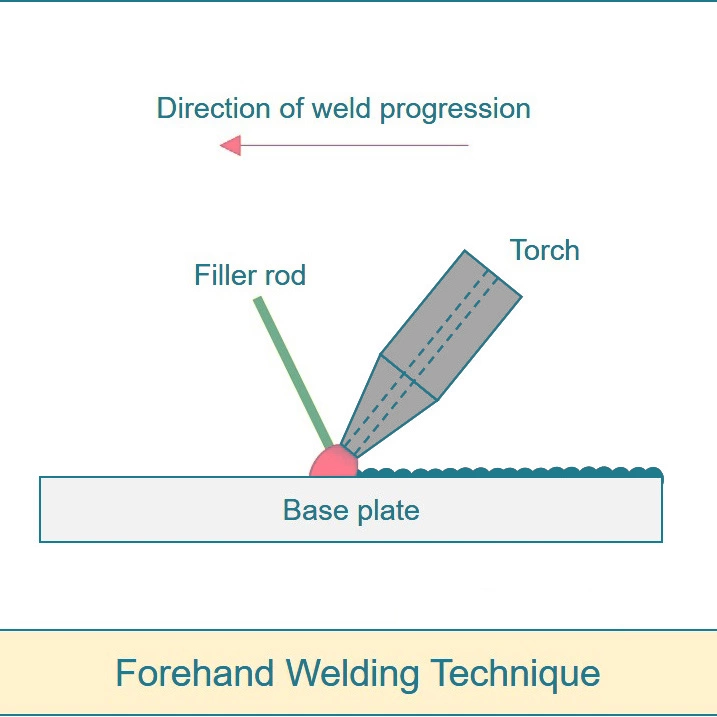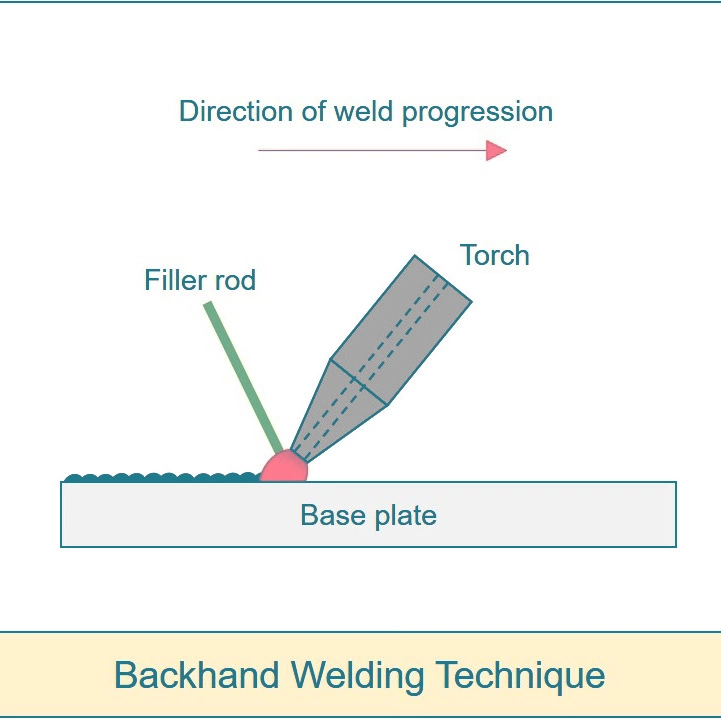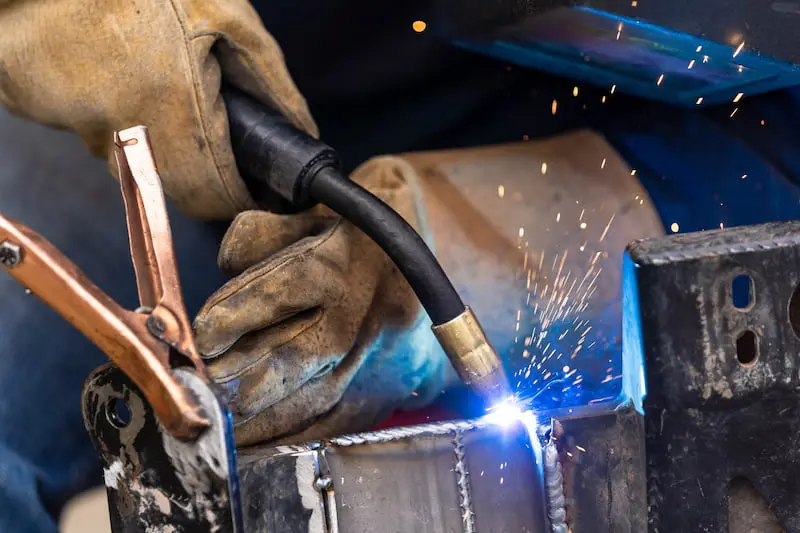While all welding methods bring out unique characteristics, there are two approaches that welders commonly discuss. Depending on the specific application, welders typically choose either forehand welding or backhand welding.
Among welders, these two are commonly known as pull welding technique and push welding technique. While they’re fundamentally the same, there is a difference between the effects and the results.

We made this article about forehand and backhand welding to highlight the critical difference and help you make the best out of your welds.
Forehand Welding Technique
Forehand welding (push welding or forward welding) includes holding the welding torch at approximately a 30-45 degree push angle. As the torch stands, the welding rod precedes the torch. The heat is pointed in the direction of welding and directed between the rod and the molten puddle.
Next, the flame and the filler rod/electrode is moved in a semi-circular fashion in opposite directions. As a result, by moving the filler rod and welding torch in the opposite direction, you can carefully melt the end of the rod and the sidewalls of the plate into a uniformly distributed molten puddle.
In addition, as you use the forehand welding, you uniformly preheat the edges of the metal, allowing excellent arc welding results.

Since the heat of the welding torch tip is pointed away from the rod, the metal is molten evenly. Overall, the forehand technique is known for excellent control of the weld puddle and penetration. In addition, forehand welding is suitable for overhead and vertical welding positions.
Even though the push welding technique allows faster weld progression, it results in a more shallow penetration. Additionally, forehand welding may result in more spatter and inconsistent arc.
Backhand Welding Technique
Backhand welding (backward welding or pull welding) is a welding technique where the electrode or flame (arc welding/gas welding) is pointed away from weld progression. Although there are exceptions, backhand welding is typically done at about a 15-degree drag angle on your right side while adding the filler metal from your left side.
In the backhand technique, the welding torch doesn’t sit above the hot weld bead. While the filler rod is applied ahead of the torch in forehand welding, the welding rod is placed behind the torch in backhand welding.
Due to the position of the torch and filler rod, you can create an even and consistent arc with backhand welding.

Backhand welding also produces less puddle and spatter so that you will use fewer rods compared to forehand welding. While the backhand welding technique doesn’t include preheating the edges, it post-heats the joints. Post heating allows continuously relieving the residual stress, which occurs through an annealing effect.
However, backhand or pull welding offers more penetration due to slower travel speed. Hence, it is more suitable for thicker metals, while it can cause burn-through when welding the sheet metal. In addition, some welders find it hard to follow welding joint when using backhand welding.
What’s The Same In The forehand and backhand welding techniques?
While reading the first part of the text, you might have noticed similarities and differences between forehand welding and backhand welding. In this section, we will discuss the similarities between these two welding techniques.
Similarities:
- Forehand or backhand strategy can be used within fusion welding processes (mostly gas welding processes, but it is equally used in most arc welding processes such as MIG welding with a welding gun).
- Filler metal can be used in fillet weld, groove weld, or tee weld joint configurations.
- Arc length or flame size are equal, regardless of the chosen welding method.
- The joint quality is based on the welders’ skill regardless of the welding technique.
Industry Use Of Backhand Welding, Forehand Welding
While “forehand welding” and “backhand welding,” indicate these techniques are only used for welding, you can use them for other fabrication processes, such as brazing and soldering.
Brazing and soldering are unique fabrication processes we covered in several different articles, but regardless of the fundamentals, you can use forehand and backhand for different fabrication processes.
Push and Pull in MIG welding
Gas Metal Arc Welding is an essential fabrication process. Professional welders have discussed whether to push or pull in MIG welding and which is the “right” way.
Push or pull, which is correct for GMAW, depends on the equipment, material, process, and personal choice. With slag, pull is the most suitable method. The push welding technique is ideal for deep penetration and when there is more area.

Pushing usually offers a better view and enables you to better direct wire into the joint. Meanwhile, Dragging typically produces deeper penetration and a narrower bead with more buildup.
Differences Between Forehand Welding and Backhand Welding
| Forehand Welding | Backhand Welding |
|---|---|
| Forehand welding involves holding and applying the torch before the rod | Backhand welding involves holding and applying the rod before the torch |
| The welding torch is placed above the deposited weld | The torch is placed above the unfilled root gap |
| Filler metal is applied ahead of the torch | Filler metal is used behind the torch |
| Preheating occurs during welding | Post heating occurs during welding |
| Preheating improves productivity by increasing the feeding rate | Post-heating helps to relieve the residual stress in the joint |
| Increased welding rod deposition rate due to faster travel speed | Lower filler deposited weld bead |
| Somewhat lesser penetration with lower weld bead profile | Higher penetration due to slower travel speed |
| Suitable for thinner materials due to lack of penetration | Best used for thicker weld metal, but can burn through thinner metal |
| Tends to form more spatter | Significantly lower spatter formation |
| Allows excellent control of the weld zone | Somewhat less control over the weld |
Resources:
- https://www.wcwelding.com/forehand-and-backhand-welding.html
- http://www.difference.minaprem.com/joining/difference-between-forehand-welding-and-backhand-welding/
- https://monroeengineering.com/blog/forehand-welding-vs-backhand-welding-whats-the-difference/
- https://www.engineeringchoice.com/forehand-welding-vs-backhand-welding/
- https://shipbuildingknowledge.wordpress.com/2018/07/19/forehand-and-backhand-welding/amp/





